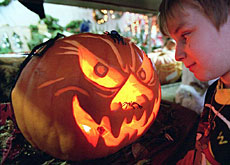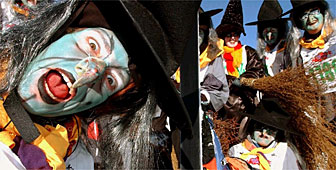Halloween creeps into Swiss popular culture

On Friday children across Switzerland will be dressing up as witches, ghosts and monsters and carving ghoulish faces into pumpkins to celebrate Halloween.
While today’s American-style celebrations are relatively new to Switzerland, the alpine nation has its own ghostly traditions linked to this time of year.
Although pumpkin lanterns are now directly associated by many Swiss with Halloween, they have a long-standing place in the country’s own customs.
According to Sergius Golowin, a writer and story collector from Bern, the use of pumpkin lanterns stems from an old belief in Switzerland that the good forces of nature retreat into the land when winter arrives.
This brought about a number of customs involving light, which was supposed to attract these good forces. It was believed these forces then provided energy throughout the winter months.
“The pumpkin, it was said, was like a battery supplying energy,” he told swissinfo. “And the energy of nature goes into the pumpkin at this time of year. So to have a pumpkin in your house gave you this energy.”
This energy, Golowin adds, also worked wonders in the bedroom, as pumpkins were known as a powerful aphrodisiac.
Ghostly procession
The strong winds common in Swiss valleys and mountains at this time of year, also have their place in Swiss folklore.
Kurt Lussi, a Swiss author and curator, says many people thought they were created by the spirits of the dead.
“People believed that when a soul left the body of a dying person, it didn’t know where to go,” he said. “So these souls are collected by the gods of these pre-Christian times and formed into a kind of procession. And all the stories of these processions of the souls are concentrated on this month.”
Some of these routes are still marked by a cross or a stone marker for those wanting to take a macabre stroll.
Pumpkin power
Halloween is adapted from an old custom of marking the last day in the Celtic calendar, which symbolised the beginning of winter.
To protect themselves against malevolent spirits, the Celts burned fires outside their homes. Today lanterns made out of hollowed-out pumpkins have replaced the fires.
The name Halloween dates back to the 16th century and is taken from “All Hallows Eve”, the day before All Saints Day in the Christian calendar on November 1.
Introduced to the United States by Irish immigrants in the 18th century, the custom was modified by Americans over the years and is now firmly ensconced in the country’s culture.
Fancy dress parties and “trick or treat” trips to neighbours houses are among the popular ways to celebrate the event.
Halloween has become increasingly popular in Switzerland, with shops selling a range of spooky costumes and decorations, including, of course, pumpkins.
swissinfo, Morven Mclean and Joanne Shields
The name Halloween dates back to the 16th century and comes from “All Hallows Eve” on October 31, the day before All Saints Day.
The custom stems from the Celtic tradition of warding off evil spirits on the last day of the Celtic calendar.
The Celtic tradition of lighting fires around the outside of homes has been modified over the years to lighting pumpkins.
Switzerland has its own traditions relating to this time of year, which also involve lighting pumpkin lanterns to protect people against malevolent spirits.

In compliance with the JTI standards
More: SWI swissinfo.ch certified by the Journalism Trust Initiative

You can find an overview of ongoing debates with our journalists here. Please join us!
If you want to start a conversation about a topic raised in this article or want to report factual errors, email us at english@swissinfo.ch.